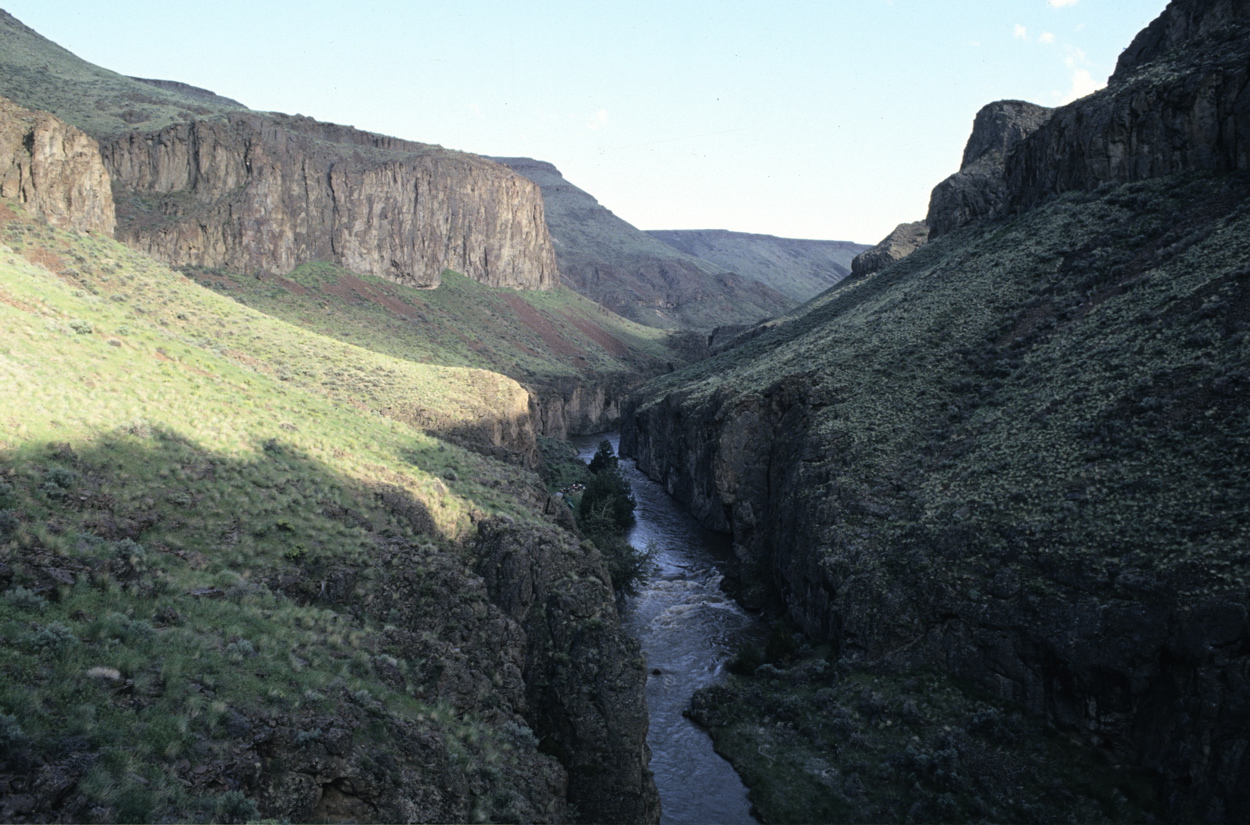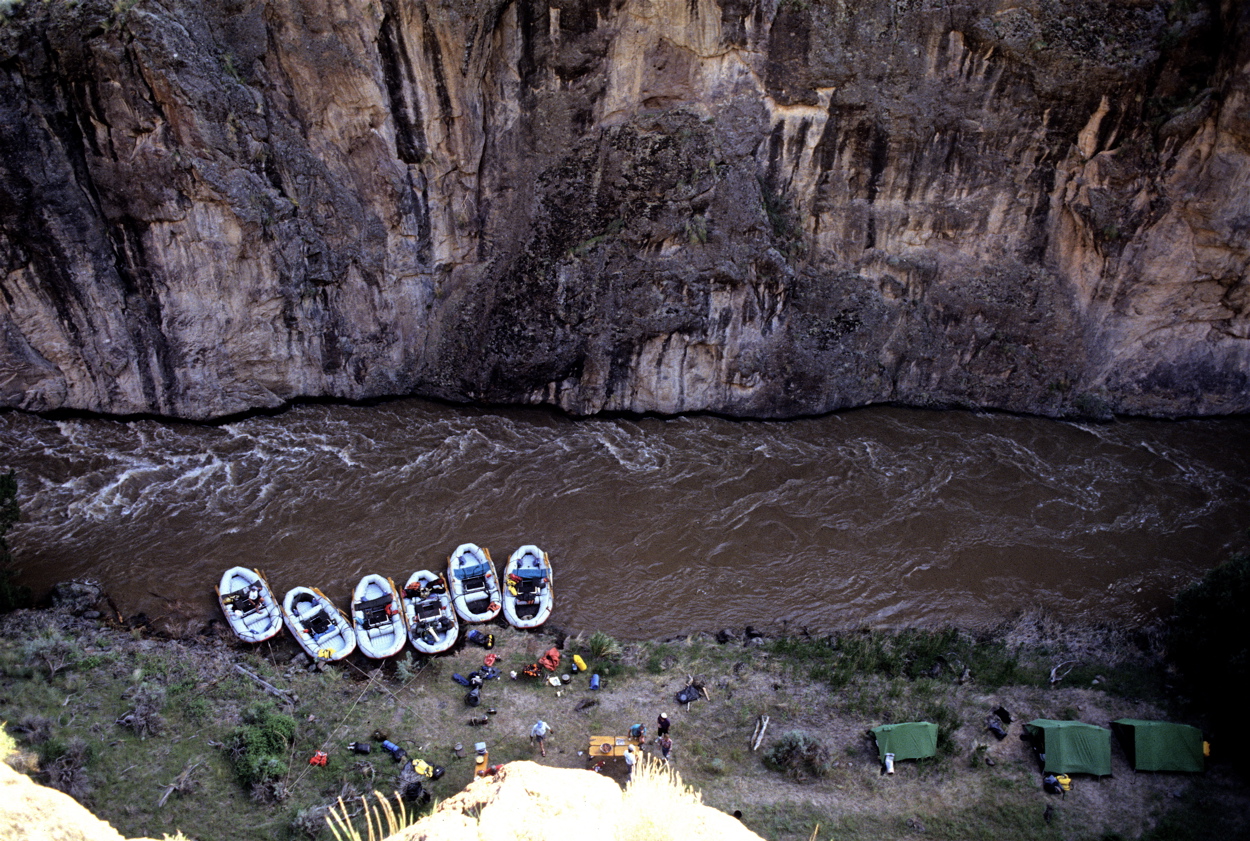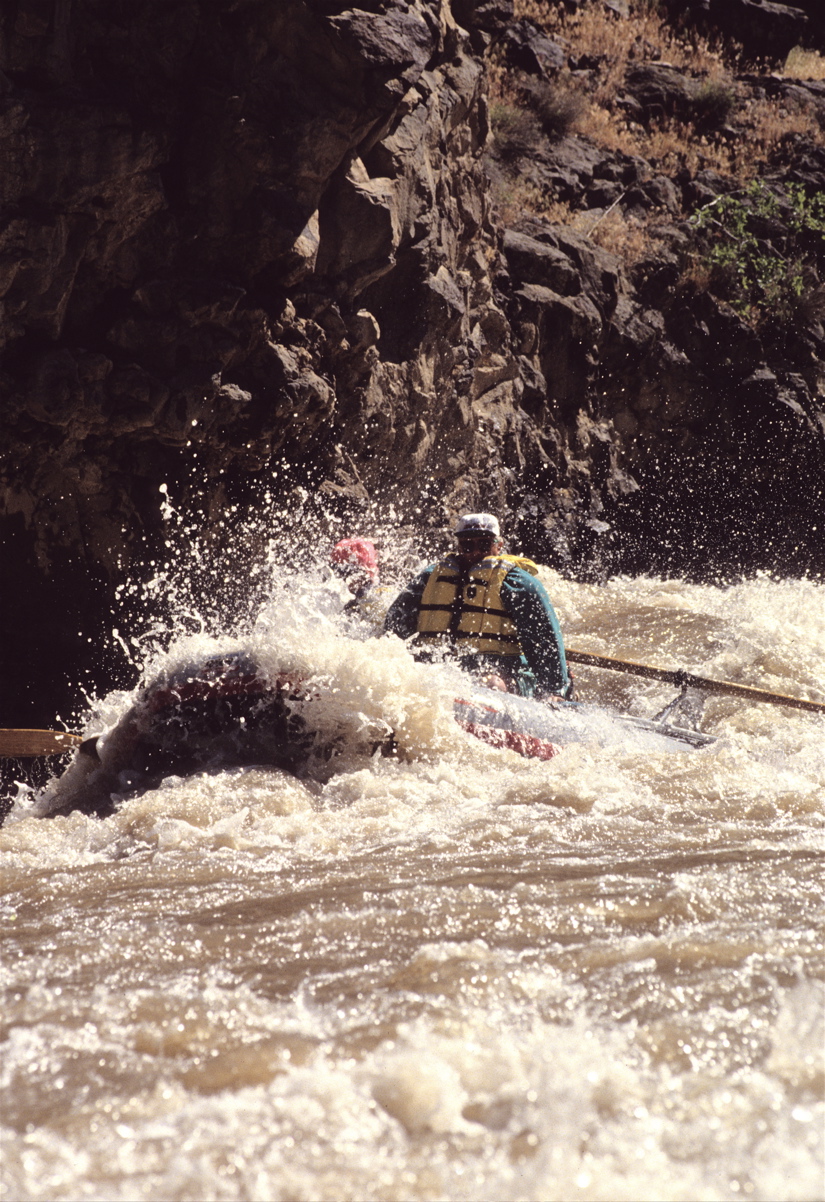Idaho: The Bruneau River
“The Bruneau most resembles a punch drunk prize fighter of the same name, staggering across Southern Idaho’s high desert.”
Brown Rapids
“If a boat goes over, it’s doubtful anyone would survive the raging rapids.”
BRUNEAU Pool
BRUNEAU Lunch Stop
“Rising to ten thousand feet, the Jarbidge are a designated wilderness area…”
BRUNEAU Camp
“…they are looking for something wild, remote and uncrowded․”
BRUNEAU Cliffs
“On the second night, guide Jim Otteson and I scale a thousand foot cliff out of the canyon where the desert stretches to the horizons in a sea of green sage and blue wild flowers.”
Dan Hawley, BRUNEAU
Barker River Expeditions
www.barkerriver.com
34808 Hassinger Rd.
Lenore, Idaho 83541
Office: (208) 836-5551
Cell: (509) 780-9599
For the past two days, John Barker has given a great deal of thought to Five Mile Rapids. In the course of its May/June season, Idaho’s Bruneau River can either mosey along at a sluggish 1000 cubic feet per second or buck like Widow Maker at 2500 CFS. Following a winter of deep snows and steady spring rains, the Bruneau is pegged at 2200 CFS–right below the red line. Barker has run this high desert river a dozen times before, but he has never run it at twenty two hundred and now can only guess at what waits in Five Mile.
As owner of Barker River Expeditions in Lenore, Idaho, John Barker has boated most of the Northwest’s major rivers and admits the Bruneau is not for everyman. This is no pebbly trout stream that holds the promise of bright sided rainbows, spawning salmon or steelhead. The Bruneau most resembles a punch drunk prize fighter of the same name, staggering across Southern Idaho’s high desert. It picks no straight course but twists and turns through the sage covered plains creating a chasm into which tributary canyons discharge their burden of red mud when the spring thunder storms rage from horizon to horizon.
Barker knows that the resulting big water can either erase the largest rapids or make them truly monstrous. He also knows that, even under ideal conditions, there are few eddies and no place to hide in Five Mile. The grade increases and the canyon walls close in until the river boils from raging cataracts to deep holes to towering waves. If we ran into trouble, it would be a long swim–five miles to be exact.
Bruneau overview
The guides who run this river know you do not want to flip in Five Mile and have been known to pray, cross themselves, invoke the Gods of Voodoo or curse wildly when the powerful current sucks their boat down the first steep brown tongue. Praying and cursing is a way of psyching themselves up, of covering all bases by petitioning both heaven and hell for safe passage. Now, as the boat accelerates toward the brown caldron, I see why. If a boat goes over, it’s doubtful anyone would survive the raging rapids.
Taking a last pull on the oars, Barker points the bow toward an eight foot wall of water that rises like a huge hammer above the boat. “Hang on,” he yells as a breaking wave roars down upon us.
The road to the Bruneau will tell you as much as you need to know about free flowing desert rivers. Barker will pay $500 to anyone willing to ferry the rubber boats, rowing frames, coolers and personals down to the put in at Indian Hot Springs. In Southern Idaho, five hundred dollars amounts to ten days pay but even at that price he doesn’t get many takers. The catch is, the drivers have to use their own trucks and they soon learn that one trip to the Bruneau is worth seventy thousand miles on paved roads.
It is early morning when we climb into a dusty GMC half ton next to a weathered ranch wife named Shirley. The first thing Shirley says is, “Buckle your belts, it’s gonna’ get rough.” The second is, “My sixteen year old boy is either gonna ride bulls in the National Pro Rodeo Finals, or die trying.” She tells us he isn’t out of high school and has already broken his shoulder and leg. “I’ll admit I had fun barrel racin’,” she continues. “But I think bulls is crazy. It’s those damn silver buckles that keeps him going.” she shakes her head at the stupidity of it all then admits, “It ain’t as if he’s already got more than he could ever wear in a lifetime.”
Midday BRUNEAU River
The four hour/thirty mile ride to Indian Hot Springs starts innocently enough as State Highway 51–a chip sealed strip of tarmac that crosses the Snake River a few miles south of Mountain Home, Idaho. In time the tarmac turns to gravel which quickly fades to a rutted dirt track where Shirley stops to engage the four wheel drive. With the hubs in, our speed slows to a casual walk toward the distant, blue outline of the Jarbidge Mountains. Rising to ten thousand feet, the Jarbidge are a designated wilderness area, that not only straddle the border between Nevada and Idaho but give birth to the Bruneau. Between the pickup and the mountains, heavy spring rains have transformed the desert into a sea of yellow Yarrow, blue Camus, Indian Paint Brush, wild iris and buck brush. For three hours the road weaves around sage brush, rain filled potholes and ledges of black lava rock before it suddenly lurches to a stop above the Bruneau Canyon.
It is here that Shirley truly earns her pay. The road down to the river amounts to little more than a narrow ledge dynamited out of the south wall. Scarred by a series of rocky stair steps, it is arguably the toughest four wheel drive road in Idaho–so precipitous in fact that before Shirley attempts the first big ledge, I abandon the pick up and walk the last mile.
A sagging bridge leads to the Indian Hot Springs from which clouds of sulfur steam taint the morning air. Perched above the hot springs, an ancient adobe cabin bears witness to a time when only horses and wagons traversed this high desert. Except for a barn owl that flushes into the bright daylight in wild, wide eyed surprise, the cabin bears no sign of habitation and offers little clue to its past purpose.
BRUNEAU Rapids
A long winter and wet spring have pushed the Bruneau over it’s banks and the decision to launch is not an easy one. John Barker admits the river is as high as he’s seen it. Twenty-two hundred CFS is not unnavigable but it is powerful enough to give him pause. To put that figure in perspective, the highest recorded flow was 3200. Spurred by heavy spring rains, the river surged 1000 CFS in 24 hours. To avoid running the thunderous cataracts, a party of kayakers climbed the sheer cliffs and walked out. Barker knows there is no escape once we commit to the current and so he cups the water in his hands, studies how the flooded willows whip in circles and looks down stream where the river bends around a bright red cliff into a shadowed canyon.
Besides Barker, myself and three guides, our party includes two investment brokers from Boise, four Little Caesar’s Pizza execs from Detroit and a graying Nevada ranch owner and his young bride. Having floated Idaho’s Middle Fork and Hells Canyon, they are looking for something wild, remote and uncrowded. Judging from the river level that shouldn’t be a problem.
As soon as that decision is made, however, the rafts are unrolled and the rigging begins in earnest. Tents, coolers and personal gear are lashed to the rowing frames and following a safety talk, we slip into our life jackets, the guides take a deep pull on the wooden oars and the rafts commit to the current.
In the first miles below Indian Hot Springs the Bruneau does little to distinguish itself. Muddy brown, it moves rapidly past grassy meadows which gradually give way to black, red and gray rhyolite walls. If Southern Idaho was forged in fire then the river has cut a path through history. It would take a geologist to unravel the geologic strata which dip, twist and turn across the sheer cliff faces where yellows, oranges and reds bleed to grays, purples and blacks that in turn give way to soft pastels.
The first day amounts to a five mile float to camp which sits on a narrow grassy bar beneath towering red cliffs. Upstream a cottonwood tree has been drowned by the current and now leans toward the opposite bank. Barker believes in roughing it in style and while two guides erect the tents, the others set up kitchen. Hors d’ oeuvres appear, a driftwood fire builds coals for the dutch ovens and the bar is broken out. Seated in folding chairs, we watch the shadows climb the canyon walls, listen to the distant romances of coyotes and marvel at a Prairie Falcon’s speed as it flies above the canyon wall. Dinner that night is nothing short of incredible. During the coming nights we will dine on steaks, chops and game hens with baked potatoes, fresh biscuits, salad, vegetables all followed by a wonderous variety of deserts. If that doesn’t fill you up, mornings start with eggs benedict, pancakes, ham, eggs and gallons of cowboy coffee. It occurs to me that Barkers’ Bruneau trip offers one of the few opportunities where you can scare yourself silly and still gain weight.
The smell of hot coffee serves as a wakeup call and after breakfast we cast into the current. The Bruneau quickens it’s pace, pulling the rafts past soaring rock spires and minarets known as hoo-doos. The Indians who once inhabited this desert believed the hoo-doos were evil spirits but aside from the Mountain Home Air Force Base fighters that periodically shriek above the canyon walls, the Bruneau moves to the sound of running water and wind. No evil can be found in either the tributary canyons named after Cougars, Sheep, Caves and Clover or the archaeologic remains of the Indians and homesteaders who scratched out a meager living along this desert oasis.
We are on the river from mid morning to early evening. In that time the river slides from wide brown holes to powerful rapids. It twists beneath towers and spikes, overhung walls and narrow tributary canyons filled with bright impressionistic splashes of yellows, reds, black grays and the color spectrum between.
Camp, BRUNEAU River
On the second night, guide Jim Otteson and I scale a thousand foot cliff out of the canyon where the desert stretches to the horizons in a sea of green sage and blue wild flowers. To the south the Jarbidge are still cloaked in snow and we perch on a hoo doo and watch the evening shadows wash over the rafts and the boaters gathered around a driftwood fire. Jeff Ross of the Twin Falls Idaho BLM estimates that less than fifteen hundred people a year float the Bruneau–a figure in large part composed of kayakers and catarafts. Compared to the hundreds of thousands that float Idaho’s other rivers, it is a negligible figure and in four days we will not see another party.
On morning of the third day, we pull to the shore above the entry to Five Mile. From the vantage point of a rock outcropping, we can only see the first few hundred yards which explode with a sparkling fury. Studying the maelstrom, I’m not sure I want to know what’s around the next bend and slip into a full wet suit, waterproof outer layer, gloves, helmet and a life vest before climbing into John’s boat.
The first breaking wave buries the self bailing boat, which staggers under the additional weight then quickly empties and claws out of the hole. John Barker is a powerful, experienced guide and yet for the next fifteen minutes the Bruneau dishes out as much as he can handle. The raft alternately lifts, dances or crashes from standing waves into deep holes where the water turns from dark brown to frothy white. I lose count of the times I brace in the bow and take the shock of the water as Barker fights to keep the bow headed down river and the raft carving safely between the buried boulders. At each bend I think Five Mile will end and at each bend the river adds a new twist, a cliff were the current curls back on itself, or a yawning hole that could easily flip a raft end for end. And at that point when there seems to be no end to the white water, the violent current slows and the raft slides into a long brown pool. Simply surviving seems like a cause to celebrate and we stare upstream and whoop with relief.
That night we toast the Bruneau over a water cooler full of Margaritas. By the third cup, we’re making promises we know we won’t keep. Promises to write, promises to trade pictures, and promises to float the Bruneau again the following spring. And listening to the coyotes howl at the full moon that hangs above the canyon wall, I realize that just as there are promises you won’t keep, there are adventures you can’t repeat.



